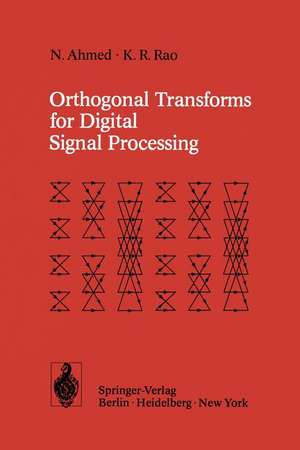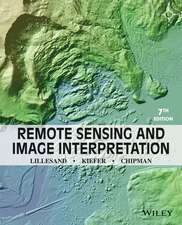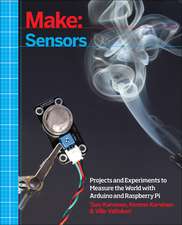Orthogonal Transforms for Digital Signal Processing
Autor N. Ahmed, K. R. Raoen Limba Engleză Paperback – 23 feb 2012
Preț: 386.99 lei
Nou
Puncte Express: 580
Preț estimativ în valută:
74.05€ • 77.52$ • 61.27£
74.05€ • 77.52$ • 61.27£
Carte tipărită la comandă
Livrare economică 05-19 aprilie
Preluare comenzi: 021 569.72.76
Specificații
ISBN-13: 9783642454523
ISBN-10: 3642454526
Pagini: 276
Ilustrații: XII, 264 p.
Dimensiuni: 155 x 235 x 14 mm
Greutate: 0.39 kg
Ediția:Softcover reprint of the original 1st ed. 1975
Editura: Springer Berlin, Heidelberg
Colecția Springer
Locul publicării:Berlin, Heidelberg, Germany
ISBN-10: 3642454526
Pagini: 276
Ilustrații: XII, 264 p.
Dimensiuni: 155 x 235 x 14 mm
Greutate: 0.39 kg
Ediția:Softcover reprint of the original 1st ed. 1975
Editura: Springer Berlin, Heidelberg
Colecția Springer
Locul publicării:Berlin, Heidelberg, Germany
Public țintă
ResearchCuprins
One Introduction.- 1.1 General Remarks.- 1.2 Terminology.- 1.3 Signal Representation Using Orthogonal Functions.- 1.4 Book Outline.- References.- Problems.- Two Fourier Representation of Signals.- 2.1 Fourier Representation.- 2.2 Power, Amplitude, and Phase Spectra.- 2.3 Fourier Transform.- 2.4 Relation Between the Fourier Series and the Fourier Transform.- 2.5 Crosscorrelation, Autocorrelation, and Convolution.- 2.6 Sampling Theorem.- 2.7 Summary.- References.- Problems.- Three Fourier Representation of Sequences.- 3.1 Definition of the Discrete Fourier Transform.- 3.2 Properties of the DFT.- 3.3 Matrix Representation of Correlation and Convolution.- 3.4 Relation Between the DFT and the Fourier Transform Series.- 3.5 Power, Amplitude, and Phase Spectra.- 3.6 2-dimensional DFT.- 3.7 Time-varying Fourier Spectra.- 3.8 Summary.- Appendix 3.1.- References.- Problems.- Four Fast Fourier Transform.- 4.1 Statement of the Problem.- 4.2 Motivation to Search for an Algorithm.- 4.3 Key to Developing the Algorithm.- 4.4 Development of the Algorithm.- 4.5 Illustrative Examples.- 4.6 Shuffling.- 4.7 Operations Count and Storage Requirements.- 4.8 Some Applications.- 4.9 Summary.- Appendix 4.1 An FFT Computer Program.- References.- Problems.- Five A Class of Orthogonal Functions.- 5.1 Definition of Sequency.- 5.2 Notation.- 5.3 Rademacher and Haar Functions.- 5.4 Walsh Functions.- 5.5 Summary.- Appendix 5.1 Elements of the Gray Code.- References.- Problems.- Six Walsh-Hadamard Transform.- 6.1 Walsh Series Representation.- 6.2 Hadamard Ordered Walsh-Hadamard Transform (WHT)h.- 6.3 Fast Hadamard Ordered Walsh-Hadamard Transform (FWHT)h.- 6.4 Walsh Ordered Walsh-Hadamard Transform (WHT)W.- 6.5 Fast Walsh Ordered Walsh-Hadamard Transform (FWHT)w.- 6.6 Cyclic and Dyadic Shifts.- 6.7 (WHT)w Spectra.- 6.8 (WHT)h Spectra.- 6.9 Physical Interpretations for the (WHT)h Power Spectrum.- 6.10 Modified Walsh-Hadamard Transform (MWHT).- 6.11 Cyclic and Dyadic Correlation/Convolution.- 6.12 Multidimensional (WHT)h and (WHT)w.- 6.13 Summary.- Appendix 6.1 WHT Computer Program.- References.- Problems.- Seven Miscellaneous Orthogonal Transforms.- 7.1 Matrix Factorization.- 7.2 Generalized Transform.- 7.3 Haar Transform.- 7.4 Algorithms to Compute the HT.- 7.5 Slant Matrices.- 7.6 Definition of the Slant Transform (ST).- 7.7 Discrete Cosine Transform (DCT).- 7.8 2-dimensional Transform Considerations.- 7.9 Summary.- Appendix 7.1 Kronecker Products.- Appendix 7.2 Matrix Factorization.- References.- Problems.- Eight Generalized Wiener Filtering.- 8.1 Some Basic Matrix Operations.- 8.2 Mathematical Model.- 8.3 Filter Design.- 8.4 Suboptimal Wiener Filtering.- 8.5 Optimal Diagonal Filters.- 8.6 Suboptimal Diagonal Filters.- 8.7 2-dimensional Wiener Filtering Considerations.- 8.8 Summary.- Appendix 8.1 Some Terminology and Definitions.- References.- Problems.- Nine Data Compression.- 9.1 Search for the Optimum Transform.- 9.2 Variance Criterion and the Variance Distribution.- 9.3 Electrocardiographic Data Compression.- 9.4 Image Data Compression Considerations.- 9.5 Image Data Compression Examples.- 9.6 Additional Considerations.- 9.7 Summary.- Appendix 9.1 Lagrange Multipliers.- References.- Problems.- Ten Feature Selection in Pattern Recognition.- 10.1 Introduction.- 10.2 The Concept of Training.- 10.3 d-Dimensional Patterns.- 10.4 The 3-Class Problem.- 10.5 Image Classification Experiment.- 10.6 Least-Squares Mapping Technique.- 10.7 Augmented Feature Space.- 10.8 3-Class Least-Squares Minimum Distance Classifier.- 10.9 K-Class Least-Squares Minimum Distance Classifier.- 10.10 Quadratic Classifiers.- 10.11 An ECG Classification Experiment.- 10.12 Summary.- References.- Problems.- Author Index.











